
The Greater Penobscot Building, commonly known as the Penobscot Building, is a class-A office tower in Downtown Detroit, Michigan. Constructed in 1928, the Art Deco building is located in the heart of the Detroit Financial District. The Penobscot is a hub for the city's wireless Internet zone and fiber-optic network.

Carew Tower is a 49-story, 574-foot (175 m) Art Deco building completed in 1931 in the heart of downtown Cincinnati, Ohio, United States, overlooking the Ohio River waterfront. The structure is the second-tallest building in the city, and it was added to the register of National Historic Landmarks on April 19, 1994. The tower is named after Joseph T. Carew, proprietor of the Mabley & Carew department store chain, which had previously operated in a building on the site.

Municipal Auditorium is a multi-purpose facility located in Kansas City, Missouri. It opened in 1935 and features Streamline Moderne and Art Deco architecture and architectural details.
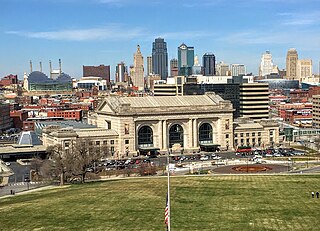
Downtown Kansas City is the central business district (CBD) of Kansas City, Missouri and the Kansas City metropolitan area which contains 3.8% of the area's employment. It is between the Missouri River in the north, to 31st Street in the south; and from the Kansas–Missouri state line eastward to Bruce R. Watkins Drive as defined by the Downtown Council of Kansas City; the 2010 Greater Downtown Area Plan formulated by the City of Kansas City defines the Greater Downtown Area to be the city limits of North Kansas City and Missouri to the north, the Kansas–Missouri state line to the west, 31st Street to the south and Woodland Avenue to the east. However, the definition used by the Downtown Council is the most commonly accepted.
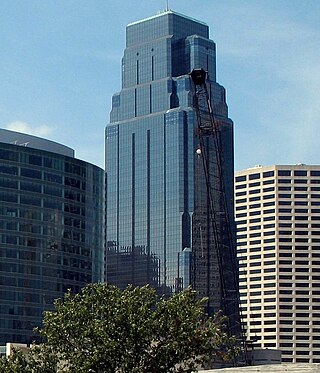
One Kansas City Place is the tallest building in the U.S. state of Missouri. It is located in Downtown Kansas City, Missouri, bounded by 12th Street to the north, Baltimore Avenue to the west, and Main Street to the east. Built in 1988, this 189.9 m / 623 ft skyscraper was designed by Patty Berkebile Nelson & Immenschuh. It replaced the Town Pavilion as the city's tallest building.

The architecture of the Kansas City Metropolitan Area, especially Kansas City, Missouri, includes major works by some of the world's most distinguished architects and firms, including McKim, Mead and White; Jarvis Hunt; Wight and Wight; Graham, Anderson, Probst and White; Hoit, Price & Barnes; Frank Lloyd Wright; the Office of Mies van der Rohe; Barry Byrne; Edward Larrabee Barnes; Harry Weese; and Skidmore, Owings & Merrill.

The Mid-Continent Tower is a 36-story skyscraper located at 401 South Boston Avenue in downtown Tulsa, Oklahoma. At 156 meters (513 ft) in height, it is the fourth-tallest building in Tulsa and fifth-tallest in Oklahoma. Faced with bright white terra cotta and crowned with a distinctive copper roof, it is one of the city's most recognizable buildings. The design is unique because the first 16-story structure was built in 1918. The top 20 stories comprise a separate structure, cantilevered over the first 66 years later. The architects of the addition matched the design of the original structure so carefully that the result is considered a single structure. It is included as a contributing structure in Tulsa's Oil Capital Historic District.

The David Stott Building is a 38 story high-rise apartment building with office space on floors 2-6 and retail space on the first floor. The "Stott" was originally built as a class-A office building located at 1150 Griswold Street in Downtown Detroit, Michigan, within the Capitol Park Historic District. It was designed in the Art Deco style by the architectural firm of Donaldson and Meier and completed in 1929. Bedrock Detroit owns and manages the building which began leasing in late 2018 and includes 107 apartment homes and 5 floors of commercial office space.
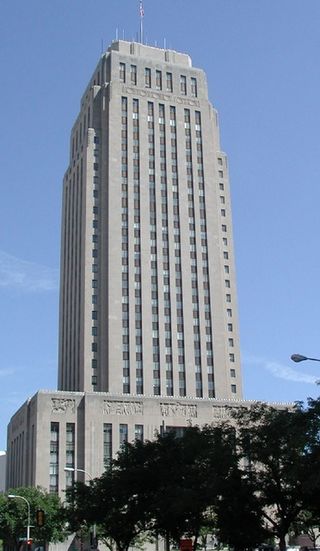
Kansas City City Hall is the official seat of government for the city of Kansas City, Missouri, United States. Located in downtown, it is a 29-story skyscraper with an observation deck. Completed in 1937, the building has a Beaux-Arts and Art-Deco style with numerous architectural features and ornamentation throughout. One Kansas City Place was modeled as a 1980s version of City Hall, and is the tallest building in Kansas City.

909 Walnut is a twin-spired, 35-story, 471-foot (144 m) residential skyscraper in Downtown Kansas City, Missouri. It was Missouri's tallest apartment building until the conversion of the Kansas City Power & Light building and the tenth-tallest habitable building in Missouri.
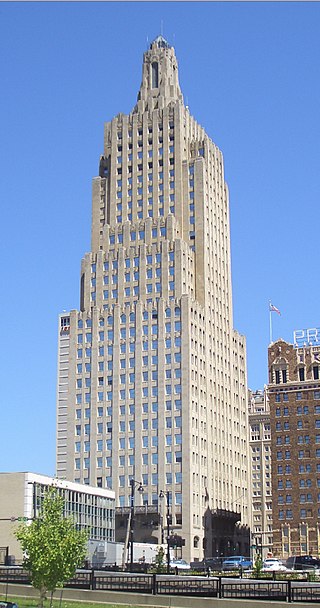
Hoit, Price & Barnes was a prominent Kansas City architectural firm in the early 20th century. It designed several skyscrapers and mansions including three of the current ten tallest buildings in Kansas City; the Kansas City Power and Light Building, 909 Walnut, and Oak Tower.

Commerce Trust Building is a 15-story tower built for Kansas City Missouri's biggest bank Commerce Bancshares in 1907 and was Kansas City's second skyscraper, following the New York Life building.
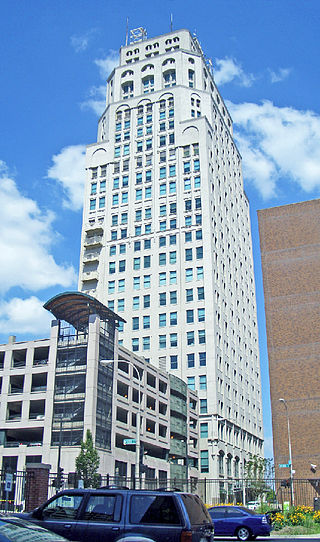
Oak Tower, also called the Bell Telephone Building, is a 28-story skyscraper in Downtown Kansas City, Missouri.

City Place is a mixed-use tower skyscraper in downtown Oklahoma City, in the U.S. state of Oklahoma. At 391 ft (119m), it is the 7th tallest building in the city and has 33 floors. Finished in 1931, it was Oklahoma City's tallest building for a short time before it lost the title to First National Center in the same year. In 2010, the top seven floors were converted into six condos; the penthouse condo occupies the top two floors.

Henry Ford Hoit was a well-known Kansas City, Missouri, architect in the early 20th century. He and his partners designed many of Kansas City's most iconic commercial and residential buildings including the Kansas City Power and Light Building and the R.A. Long residence.

























